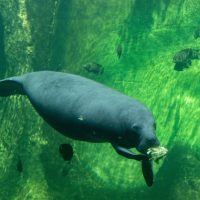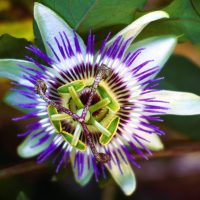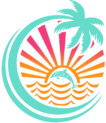North Bay Native Species Mural in Vogel Park
This colorful, detailed mural wraps around the small building in Vogel Park and depicts native marine and pollinator species. It brings to life and connects residents to the biodiversity found in our local ecosystem. The mural was painted by brush by the artist team from Before It’s Too Late, a local nonprofit creating public art experiences that educate and inspire the community to take better care of our natural world.

Artists
Species Index

- (Ardea Herodias)
- Status: Least Concern
- Size: 3.2 – 4.5 ft
- Lifespan: 15 yrs
A great blue heron has a wingspan of 6 feet. Their long legs and S-shaped neck make them pretty impressive when they fly. They’re about 3 feet tall when standing, but they can stretch to 4 feet.

- (Papilio Glaucus)
- Status: Secure
- Size: 3.12 to 5.5 in.
- Lifespan: 2 weeks approximately
As the Eastern Tiger Swallowtail caterpillar matures, it turns green with orange and black false eyespots. The eye spots are a type of deceptive coloration that protects the caterpillar from predators. Seeing the eye spots, predators think the caterpillar is much larger than it really is!

- (Caretta Caretta)
- Status: Vulnerable
- Size: 3 ft
- Lifespan: 70 to 80 yrs
Loggerhead turtles are named for their broad, muscular heads. They use their heads and powerful jaws to crush the shells of queen conch, spiny lobsters and other hard-shelled invertebrates. The loggerhead turtle is the most common sea turtle found in Florida.

- (Asclepias Tuberosa)
- Status: Least Concern
A monarch caterpillar can only feed on milkweed leaves, which is its only host plant. As a result, milkweed is crucial to monarch survival. They cannot complete their life cycle without it.

- (Trichechus Manatus)
- Status: Vulnerable / Threatened
- Size: 11 ft
- Lifespan: 50 to 60 yrs
Manatees are more closely related to the elephant than they are to other marine creatures. Each species of manatee is a member of the sirenius family, which shares a common ancestor with the elephant, aardvark and small gopher-like hyrax.

- (Danaus Plexippus)
- Status: Endangered
- Size: 3 to 4 in
- Lifespan: 8 mos
Monarchs are common in South Florida. Florida’s warm climate and continuous growing season keep the species hanging around throughout the year. The South Florida region is a destination point for migrating Monarch butterflies from Canada and the Northeast.

- (Passiflora Cochinchinensis)
- Status: Least Concern
- Size: 3 in flowers
Passionflower is a perennial, flowering vine. Perennial means that it grows all year round. The passionflower is native to Florida and easy to grow. It attracts many types of pollinators and grows a delicious tangy fruit.

- (Rhizophora Mangle)
- Status: Least Concern
- Size: Beyond 20 ft
Mangroves are the only species of trees in the world that can tolerate saltwater. They are halophytes, meaning they can tolerate salt and are able to live in areas where oceans and seas meet the land. Mangroves are hotspots of biodiversity.

- (Apis Mellifera)
- Status: Extinct and Data Deficient
- Size: ½ to ⅝ in
- Lifespan: 21 to 60 days for Workers / 1 to 2 years for Queen
Honey bees are really important for pollinating our food supply. In Florida, common crops like blueberries, watermelons, cucumbers and onions would produce little to no fruit if it were not for the honey bee.

- (Archilochus Colubris)
- Status: Least Concern
- Size: 3.5 in
- Lifespan: 3- 5 years
Ruby-throated Hummingbirds are the most common hummingbirds in Florida. To fuel its energetic movements, this hummingbird may eat twice its body weight in a day. It often plucks insects from spider webs or catches them in flight.
Conservation Tips
Natives, nonnatives, invasive explanation + resources:
Native plants are plants that evolved to live here on their own, without humans bringing them or taking care of them. Nonnative plants are introduced by humans. Not every nonnative plant is harmful to the environment, but there are some that escape gardens and spread into natural areas. They may spread by seeds, spores, or plant pieces, and they can spread very quickly. Plants like these are called invasive – they compete with native plants for nutrients, sunlight, and space, and too often they win! This makes it harder and harder for native plants to live, changing the special Florida habitats that are home to unique plants and animals.
The big problem with invasive species is that by taking over large areas they reduce biodiversity, the number of different species in an ecosystem. Since humans brought the plants into the ecosystem, many feel that it is our responsibility to manage the problem. Land managers do this by removing invasive species from our natural areas.
But you don’t need to be a land manager to help! If you have a garden, you can see which plants are there. If you have an invasive plant, remove it so that it does not spread. Then decide which native plants you would like in your garden! You can make your garden on a patio or even by a window using pots or planters. Make sure to read about the plants so you know how much sun and water they need. The cool thing about native plants is that since they evolved to live here, they usually do not need a lot of attention. They do well on their own.
This mural shows you a few of the native species we want to grow and protect, but there are many more.
You can learn more at:
IRC “Natives for your Neighborhood” https://www.regionalconservation.org/beta/nfyn/default.asp
FNPS “Native plants for your area” https://www.fnps.org/plants
FNPS Resources https://www.fnps.org/resources/pubs
____________________
Florida has many aquatic ecosystems – mangrove forests, wetlands (the Everglades, marshes, swamps), lakes, and the waters of the Atlantic Ocean and the Gulf of Mexico. In Wetlands, water covers the soil for all or part of the year. They can experience dry periods when water covers a much smaller area. The water in a wetland is not as deep as in an ocean or a lake.
Florida is famous for its Everglades wetland, where the water is brackish, a mix of fresh and salt water. In the Everglades, sawgrass sticks up high out of the water. Birds like Great blue heron, Anhinga, and Osprey wade in the water looking for fish to eat. Sometimes the water in the Everglades gets lower, leaving certain parts dry and forcing fish to gather in a smaller area. Usually, birds lay their eggs and care for the babies during the dry season, because it is easier to find fish for the babies.
Florida is also a very special place where sea turtles make their nests. The Loggerhead sea, named for its massive block-like head, is Florida’s most common sea turtle. Using its powerful jaws, it can crush and eat clams, crabs, and other hard-shelled animals. Female loggerheads come back to the same nesting beach every 2 or more years to lay their eggs. Unfortunately, the loggerhead is now listed as a threatened species due to accidental capture by fishing nets, beach development, and increased predation on nests.
You can help the loggerhead and other sea turtles by making sure that you do not shine bright lights at the beach at night, especially not during turtle-hatching season. The light confuses the babies, who are looking for moonlight to find the ocean. Many counties and cities in Florida have passed ordinances (rules) prohibiting light from reaching the beach. Miami-Dade county hasn’t passed a county-wide ordinance, but five cities in Miami have passed it.
You can also participate in beach cleanups or organize your own! Beach cleanups bring many people together to remove lots of trash off the beach. The more trash we can remove together, the less that ends up in the ocean where animals confuse it for food. You can look up organizations like Clean Miami Beach and One Beautiful World to find out more.
You can even volunteer to help locate nests, mark them, count eggs, and help turtles that had some trouble getting out of the nest. The Turtle Team of Volunteering Miami and the Miami-Dade Sea Turtle Conservation Program have volunteer opportunities.
_____________________
Firebush
scientific name: Hamelia patens
Firebush is a shrub that may reach up to 12 feet high, with orange flowers that you could say resemble little fires. These flowers attract bees, butterflies, and hummingbirds, making firebush a perfect plant for a Florida butterfly garden. The flowers turn into dark purple fruits that attract birds. This plant grows best in partial sun and fertile soil. If you plan to buy a firebush, be aware that many commercial plant sellers sell other nonnative firebush species that look similar; you may need to ask if they are selling the native firebush – the scientific name is helpful for this!
____________________
Passionflower Vine
scientific name: Passiflora incarnata
This winding vine climbs using tendrils and makes beautiful purple blooms. It is a food source for the caterpillars of the Zebra Longwing, Gulf Fritillary, and Julia butterflies. Plant Passionflower along a fence or trellis to give it room to climb and attract these important native butterfly species!
